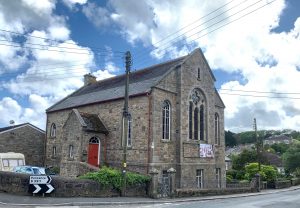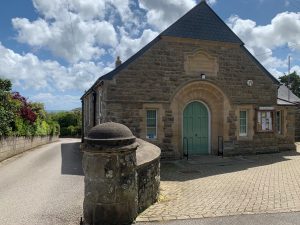Mapping Methodism – Gulval Wesleyan Chapel (also known as Trevarrack)
Categories Mapping Methodism0 Comments
Gulval is a village now considered to be a suburb of Penzance. This profile of Gulval Wesleyan Chapel has been compiled by Jo Lewis and Tony Mansell.
1822 Chapel
John Wesley preached at Gulval and had great influence in the village. In 1744 he writes of preaching and ‘regulating’ a society near Gulval.
The original Gulval chapel lay on the east side of Trevarack Road, not far from its replacement. It is thought to date from 1822 (now Wesley Villa, a private house).
A Wesleyan Methodist chapel is recorded on the 1st Edition 1:2500 1880 OS Map slightly to the south of Gulval Cross. On the 2nd Edition 1907 OS Map a building is still marked but not labelled and there is a building labelled ‘Wesley Villa’ on the current Mastermap. By 1907 a new Methodist chapel 138576 is recorded which is still extant. (Cornwall Heritage Gateway)
1837: Possible registration date. (SWChurches)
1880: New Alexandre harmonium obtained. (The Cornish Telegraph – Thursday 14 October 1880)
1884 Chapel
 (Photo: Jo Lewis)
(Photo: Jo Lewis)
 (Photo: Jo Lewis)
(Photo: Jo Lewis)
The new chapel, at the junction with Green Hill was built in 1884 with a Sunday school underneath.
Nonconformist chapel. 1884 datestone. Killas rubble with granite dressings; dry Delabole slate roof with coped gable ends and brick stack over rear gable; crested and pierced clay ridge tiles; original cast-iron rainwater goods. Rectangular plan with chapel, with horseshoe amphitheatre seating arrangement, over basement schoolroom, the chapel with porch to centre of left-hand return approached by a ramp from the road. Interesting blend of simple Classical style with some Gothic features. 2-storey elevations; 3-bay ritual east end as road front, the central bay broken forward from an incomplete pediment. The central chapel bay has a mid-Gothic style 3-light granite window with quatrefoil rose tracery. The other chapel windows are round arched with glazing bars continued as margin glazing to the arch. There are 4 bays to the right-hand return. The left-hand return has a gabled porch with a round-arched doorway to its front side; spoked fanlight over panelled doors. The basement windows are transomed with glazing bars; basement as plinth. INTERIOR is complete and unaltered. The plastered ceiling is trefoil in section (giving the impression of nave with flanking aisles) rising from a moulded cornice and with moulded ribs marking the truss positions. At the ritual east end is a tripartite arrangement of 3 round moulded arches carried on fluted piers and responds with moulded caps with enriched cornices. FITTINGS: original pitch-pine fittings include pews with shaped ends with ceramic numbers, all the pews ramped up from a small central horseshoe-shaped area of floor with bow-fronted communion rail on turned balustrade over step in front. The rostrum has a bowed S-panel centre with arched panels, pilasters and moulded cornices flanked by short straight sections surmounted by turned balustrades and terminal turned lamp stands with panelled bases over fluted pilasters. There is a short flight of stairs with open string and turned balusters at either side. Behind the rostrum is a shallow end gallery with pilasters and panels with diagonal boarding. SUBSIDIARY FEATURES: low rubble and granite-coped forecourt walls and 2 pairs of square granite gate-piers with pyramid caps; iron gates and railings. Gulval Methodist Church is one of the best examples of a nonconformist chapel of this date in Cornwall. It’s curious blend of Classical style and Gothic style features but is a well-balanced design, which groups with a virtually unaltered row of small early C19 houses. The plan arrangement IS here combined with high external quality and a good interior arranged as a semi-amphitheatre. Listing NGR: SW4793331642 (Historic England)
Methodist chapel with schoolroom underneath. Granite rubble with granite dressings under a dry slate roof. Interesting eclectic design with a central Gothic style traceried stone window but with otherwise simple classical style features. Very complete and unaltered and with good context adjoining a terrace of unaltered early C19 cottages with original sash windows. Good interior with original fittings, the pews galleried around a horse-shoe plan. Good subsidiary features.
Good late example occupying a prominent site in the village with much late C19 character, much built by the Bolitho Estate. Conversion to domestic use for an artist and use of the chapel auditorium as a studio has involved minimal alteration to the building (1). (Cornwall Heritage Gateway)
25th January 1884: Memorial stone laid. (Wiki)
1884: Laying the memorial stone. (The Cornish Telegraph – Thursday 31 January 1884)
1884: Build date. (Cornwall Heritage Gateway / SWChurches)
Built as a Wesleyan chapel. (SWChurches)
The architect was James Hick of Redruth and the contractor was William Mitchell of Scorrier who received £1400 for the work. (Wiki)
1884: NEW WESLEYAN CHAPEL, GULVAL This (Wednesday) afternoon is great day with the Wesleyans of Gulval. They have opened the neatly designed, substantially built and comfortably arranged chapel that they have desired for many a long year. The ceremony was the simplest character. It was at once put to the use for which it had been erected – the preaching of the gospel, the service being conducted by the Rev. E. Watson, chairman of the district… The new chapel, the memorial-stone of which was laid by W. Bickford-Smith, Trevarno, about a year ago, is 58ft. 6in. by 38ft. without, and is two storeys in height, the basement containing schoolroom, two class-rooms, heating chamber, &c. The chapel is placed over the schoolroom and provides accommodation for about 250. At the rear of the rostrum is an orchestra for a choir of 30. This opens into the chapel massive archway supported on pilasters. On the left of the orchestra is a minister’s vestry, lavatory, etc. The entrance to the chapel is at the side, and advantage has been taken of the different levels of the ground and raised slope to avoid steps to the chapel. The seats are arranged in the form of an amphitheatre. The arched ceiling of plaster divided into panels by moulded ribs and has a very pleasing effect. The window of the orchestra and the centre window of tbc front gable are each three lights, built of Wild Duck stone with traceried heads and filled with cathedral-tinted glass. The height of the walls from ground to roof is 32ft., and to the ridge of roof about 48ft. The walls are erected of local stone with granite dressings. Externally the appearance of the chapel is plain and substantial; internally the effect is all that could be desired, both as regards appearance and the studied arrangements for seeing and hearing. The joinery is of pitch pine varnished and the rostrum especially is an elegant piece of workmanship. The contractor, who has done his work in a most satisfactory manner, is Mr William Mitchell, of Scorrier, the architect being J. Hicks, of Redruth. The contract was £1,400 and the total expenditure will be about £1,600…” (The Cornish Telegraph – Thursday 30 October 1884)
Circa 1884: Subscription list, construction of new chapel, Gulval Wesleyan Chapel, Penzance. Printed subscription list for building Gulval new chapel, not dated. Found loose in MR/PZ/514. (Kresen Kernow MRPZ/527)
1888: “FOR SALE, LARGE HARMONIUM (very powerful, 44 sets of vibrators, by Alexandre, 14 stops, knee and heel swells), warranted in excellent condition, the property the Gulval Wesleyan Chapel Trustees. For disposal in Consequence of its being replaced by an organ; a rare bargain…” (The Cornish Telegraph – Thursday 05 July 1888)
1889: The chapel was given a grade II listing. (Wiki)
1902: Organ renovated. (Cornishman – Thursday 30 October 1902)
1932: The Wesleyan, Primitive Methodist and the United Methodist Church amalgamated to become the Methodist Church of Great Britain.
1932: Became Gulval Methodist Church. (SWChurches)
1975: The Sunday school tea treat at Gulval on the 19th of July 1975 was described as an unqualified success. It seems that the threat of rain made it necessary to hold the tea in Lanisley Hall, but other aspects were unaffected. There was a fancy-dress parade and pony rides and good use was made of the field for other events.
2004: Probable closure date. (SWChurches)
The Chapel was sold and the congregation now meet in the old Sunday school which is also the village hall (as picture)
